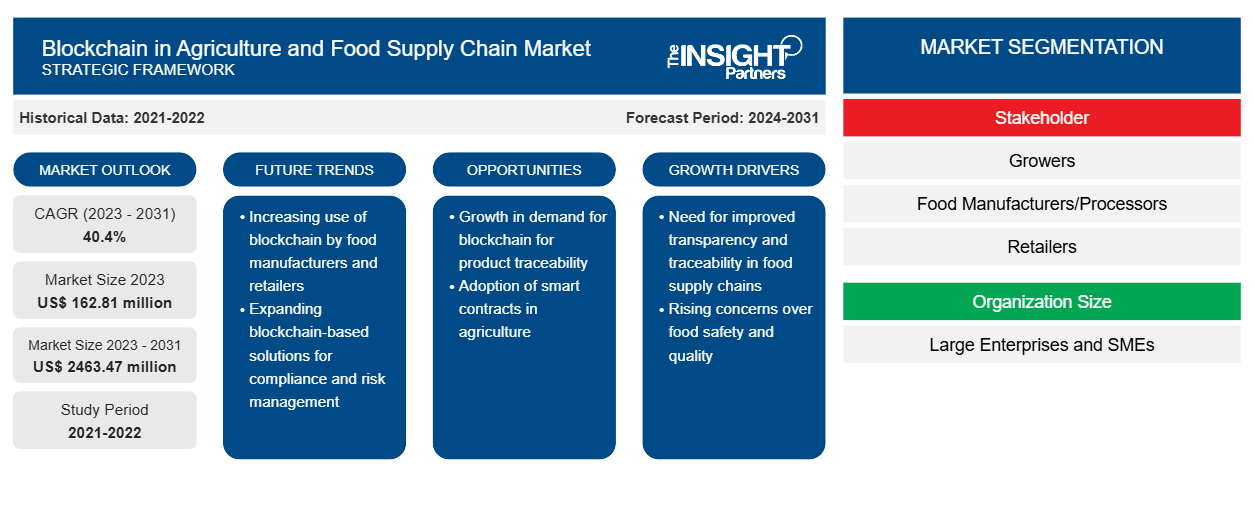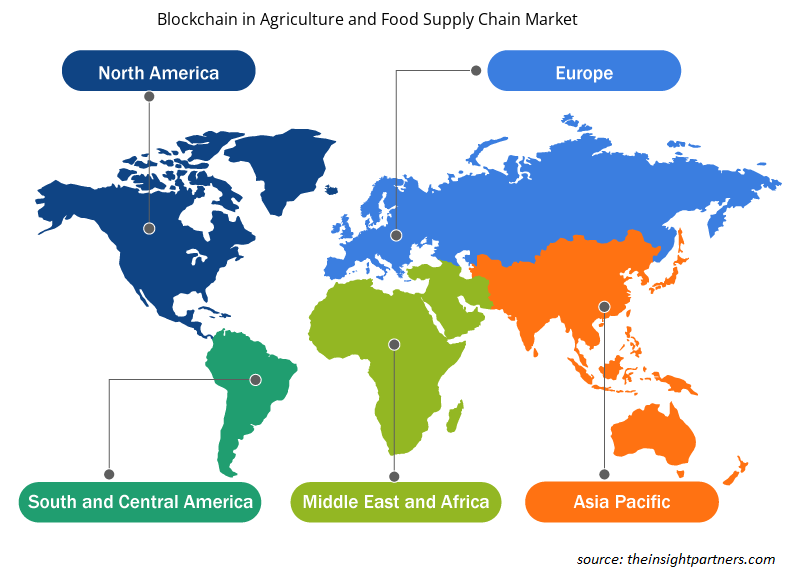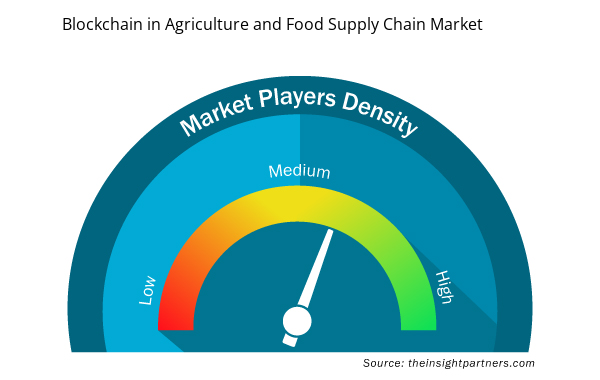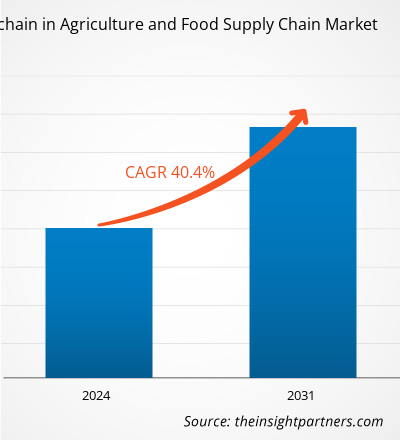La taille du marché de la blockchain dans l'agriculture et la chaîne d'approvisionnement alimentaire devrait passer de 162,81 millions USD en 2023 à 2 463,47 millions USD d'ici 2031 ; elle devrait croître à un TCAC de 40,4 % de 2023 à 2031. La traçabilité et la transparence améliorées, la demande des consommateurs en matière de transparence, l'efficacité de la chaîne d'approvisionnement, la prévention de la fraude et de la contamination alimentaires et la réduction du gaspillage alimentaire alimentent la croissance de la blockchain dans le marché de l'agriculture et de la chaîne d'approvisionnement alimentaire.
Analyse du marché de la blockchain dans la chaîne d'approvisionnement agricole et alimentaire
La demande croissante de la technologie blockchain de la part des petites et moyennes entreprises a renforcé la présence de la blockchain sur le marché de la chaîne d'approvisionnement agricole et alimentaire. En outre, l'intégration des appareils de l'Internet des objets (IoT) devrait accélérer l'expansion des marchés au cours de la période prévue. De plus, les grandes entreprises prennent diverses initiatives pour élargir leur portefeuille et leur présence mondiale, ce qui est devenu une tendance majeure de la blockchain sur le marché de la chaîne d'approvisionnement agricole et alimentaire.
Aperçu du marché de la blockchain dans la chaîne d'approvisionnement agricole et alimentaire
- Les entreprises du secteur agricole s'intéressent de plus en plus à la technologie blockchain. Les entreprises se démarquent progressivement en montrant comment les connaissances de la chaîne d'approvisionnement sont créées et les goulots d'étranglement des transactions sont réduits grâce à une meilleure compétence en gestion des données résultant du développement de la technologie.
- Le secteur agricole montre à quel point la technologie est précieuse pour réduire les coûts de transaction, rationaliser la logistique, améliorer la traçabilité et améliorer les procédures de sécurité alimentaire.
- La technologie Blockchain représente une opportunité passionnante d’améliorer la transparence, de réduire la résistance et de stimuler l’efficacité des transactions dans les chaînes d’approvisionnement agricoles mondiales.
Personnalisez ce rapport en fonction de vos besoins
Vous bénéficierez d'une personnalisation gratuite de n'importe quel rapport, y compris de certaines parties de ce rapport, d'une analyse au niveau des pays, d'un pack de données Excel, ainsi que de superbes offres et réductions pour les start-ups et les universités.
La blockchain dans le marché de l'agriculture et de la chaîne d'approvisionnement alimentaire : perspectives stratégiques

- Obtenez les principales tendances clés du marché de ce rapport.Cet échantillon GRATUIT comprendra une analyse de données, allant des tendances du marché aux estimations et prévisions.
Opportunité de marché pour la blockchain dans la chaîne d'approvisionnement agricole et alimentaire
L'intégration des appareils de l'Internet des objets (IoT) va créer une opportunité pour la blockchain dans la croissance du marché de la chaîne d'approvisionnement agricole et alimentaire
- L’intégration des appareils de l’Internet des objets (IoT) à la technologie blockchain pour les chaînes d’approvisionnement agricoles et alimentaires améliore la collecte de données et la surveillance en temps réel, conduisant à une transparence, une traçabilité et un contrôle de la qualité accrus, ainsi qu’à une efficacité accrue de la chaîne d’approvisionnement.IoT) devices with blockchain technology for agriculture and food supply chains improves data gathering and real-time monitoring, leading to increased transparency, traceability, and quality control, as well as increased supply chain efficiency.
- Les entreprises sécurisent les données des appareils IoT grâce à la blockchain. Les appareils intelligents peuvent échanger des données et mener d'autres activités financières de manière évolutive, sécurisée et fiable lorsque la technologie blockchain est utilisée conjointement avec les appareils IoT.
- De plus, la technologie blockchain combinée à l’IoT permet aux organisations d’échanger et d’accéder aux données sans avoir besoin d’un contrôle et d’une gestion centralisés, propulsant ainsi davantage la blockchain dans la croissance du marché de la chaîne d’approvisionnement agricole et alimentaire.
Analyse de segmentation du rapport sur le marché de la blockchain dans la chaîne d'approvisionnement agricole et alimentaire
- En fonction de la taille de l'organisation, le marché de la blockchain dans l'agriculture et la chaîne d'approvisionnement alimentaire est segmenté en grandes entreprises et PME. Le segment des grandes entreprises devrait détenir une part substantielle du marché de la blockchain dans l'agriculture et la chaîne d'approvisionnement alimentaire en 2023.
- Les grandes organisations s’efforcent en permanence d’investir dans des technologies avancées comme la blockchain pour améliorer leur chaîne d’approvisionnement agricole et alimentaire, ce qui alimente la croissance du segment sur le marché.
- Les PME travaillent également à l’adoption de la technologie blockchain, car elle les aide à suivre et à gérer leurs céréales tout au long de la chaîne de valeur, propulsant ainsi davantage la croissance du marché au cours de la période prévue.
Analyse des parts de marché de la blockchain dans la chaîne d'approvisionnement agricole et alimentaire par zone géographique
Le marché de la blockchain dans l'agriculture et la chaîne d'approvisionnement alimentaire est principalement divisé en cinq régions : l'Amérique du Nord, l'Europe, l'Asie-Pacifique, le Moyen-Orient et l'Afrique et l'Amérique du Sud. L'Amérique du Nord connaît une croissance rapide et devrait détenir une part de marché importante de la blockchain dans l'agriculture et la chaîne d'approvisionnement alimentaire. L'Amérique du Nord a adopté la technologie moderne à un rythme beaucoup plus rapide que les autres régions pour gérer l'agriculture et la chaîne d'approvisionnement alimentaire, ce qui lui a valu la plus grande part de marché. En outre, les États-Unis et le Canada sont les pays les plus stables économiquement de la région, représentant une part importante du marché.
Aperçu régional du marché de la blockchain dans l'agriculture et la chaîne d'approvisionnement alimentaire
Les tendances et facteurs régionaux influençant le marché de la blockchain dans l’agriculture et la chaîne d’approvisionnement alimentaire tout au long de la période de prévision ont été expliqués en détail par les analystes d’Insight Partners. Cette section traite également des segments et de la géographie du marché de la blockchain dans l’agriculture et la chaîne d’approvisionnement alimentaire en Amérique du Nord, en Europe, en Asie-Pacifique, au Moyen-Orient et en Afrique, ainsi qu’en Amérique du Sud et en Amérique centrale.

- Obtenez les données régionales spécifiques pour le marché de la blockchain dans la chaîne d'approvisionnement agricole et alimentaire
Portée du rapport sur le marché de la blockchain dans la chaîne d'approvisionnement agricole et alimentaire
| Attribut de rapport | Détails |
|---|---|
| Taille du marché en 2023 | 162,81 millions de dollars américains |
| Taille du marché d'ici 2031 | 2 463,47 millions de dollars américains |
| Taux de croissance annuel composé mondial (2023-2031) | 40,4% |
| Données historiques | 2021-2022 |
| Période de prévision | 2024-2031 |
| Segments couverts | Par partie prenante
|
| Régions et pays couverts | Amérique du Nord
|
| Leaders du marché et profils d'entreprises clés |
|
Densité des acteurs du marché de la blockchain dans la chaîne d'approvisionnement agricole et alimentaire : comprendre son impact sur la dynamique des entreprises
Le marché de la blockchain dans l'agriculture et la chaîne d'approvisionnement alimentaire connaît une croissance rapide, tirée par la demande croissante des utilisateurs finaux en raison de facteurs tels que l'évolution des préférences des consommateurs, les avancées technologiques et une plus grande sensibilisation aux avantages du produit. À mesure que la demande augmente, les entreprises élargissent leurs offres, innovent pour répondre aux besoins des consommateurs et capitalisent sur les tendances émergentes, ce qui alimente davantage la croissance du marché.
La densité des acteurs du marché fait référence à la répartition des entreprises ou des sociétés opérant sur un marché ou un secteur particulier. Elle indique le nombre de concurrents (acteurs du marché) présents sur un marché donné par rapport à sa taille ou à sa valeur marchande totale.
Les principales entreprises opérant sur le marché de la blockchain dans la chaîne d'approvisionnement agricole et alimentaire sont :
- IBM
- Microsoft
- TE-FOOD International GmbH
- Ambroise
- Réseau ACR
- SAP SE
Avis de non-responsabilité : les sociétés répertoriées ci-dessus ne sont pas classées dans un ordre particulier.

- Obtenez un aperçu des principaux acteurs clés du marché de la blockchain dans l'agriculture et la chaîne d'approvisionnement alimentaire
« Analyse du marché de la blockchain dans l'agriculture et la chaîne d'approvisionnement alimentaire »L'étude a été réalisée en fonction des parties prenantes, de la taille de l'organisation, de l'application et de la géographie. En fonction des parties prenantes, le marché est segmenté en producteurs, fabricants/transformateurs de produits alimentaires et détaillants. En fonction de la taille de l'organisation, le marché est segmenté en grandes entreprises et PME. En fonction de l'application, le marché de la blockchain dans l'agriculture et la chaîne d'approvisionnement alimentaire est segmenté en traçabilité des produits, paiement et règlement, contrats intelligents et gestion des risques de gouvernance et de la conformité. En fonction de la géographie, le marché est segmenté en Amérique du Nord, Europe, Asie-Pacifique, Moyen-Orient et Afrique et Amérique du Sud.
Actualités et développements récents du marché de la blockchain dans l'agriculture et la chaîne d'approvisionnement alimentaire
Les entreprises adoptent des stratégies organiques et inorganiques telles que les fusions et acquisitions dans la blockchain sur le marché de la chaîne d'approvisionnement agricole et alimentaire. Quelques développements clés récents du marché sont énumérés ci-dessous :
- En mars 2021, BlockApps, un fournisseur de plateforme blockchain d'entreprise, a annoncé l'extension du réseau TraceHarvest avec Amazon Web Services (AWS). La solution blockchain TraceHarvest de BlockApps s'appuiera sur AWS pour fournir aux clients agroalimentaires de TraceHarvest un accès rapide et flexible au cloud. TraceHarvest permet aux clients de suivre et de tracer le cycle de vie complet des produits agricoles à partir de la source des semences à l'aide de la blockchain.
[Source : BlockApps, site Web de l'entreprise]
- En janvier 2020, Farmer Connect et IBM ont annoncé une nouvelle application mobile grand public appelée « Thank My Farmer », qui permettra aux amateurs de café de retracer leur café pour comprendre sa qualité et son origine et même de soutenir l'agriculteur qui a cultivé les grains. Farmer Connect est une plateforme de traçabilité alimentée par IBM Blockchain conçue pour aider à accroître la traçabilité, l'efficacité et l'équité dans la chaîne d'approvisionnement du café.
[Source : IBM, site Web de l'entreprise]
Rapport sur le marché de la blockchain dans la chaîne d'approvisionnement agricole et alimentaire et couverture des livrables
Les prévisions du marché de la blockchain dans l'agriculture et la chaîne d'approvisionnement alimentaire sont estimées sur la base de diverses conclusions de recherche secondaires et primaires, telles que les publications clés des entreprises, les données des associations et les bases de données. Le rapport de marché « Blockchain in Agriculture and Food Supply Chain Market Size and Forecast (2021-2031) » fournit une analyse détaillée du marché couvrant les domaines ci-dessous-
- Taille et prévisions du marché aux niveaux mondial, régional et national pour tous les segments de marché clés couverts par le périmètre.
- Dynamique du marché telle que les moteurs, les contraintes et les opportunités clés.
- Principales tendances futures.
- Analyse PEST et SWOT détaillée
- Analyse du marché mondial et régional couvrant les principales tendances du marché, les principaux acteurs, les réglementations et les développements récents du marché.
- Analyse du paysage industriel et de la concurrence couvrant la concentration du marché, l'analyse de la carte thermique, les principaux acteurs et les développements récents.
- Profils d'entreprise détaillés.
- Analyse historique (2 ans), année de base, prévision (7 ans) avec TCAC
- Analyse PEST et SWO
- Taille du marché Valeur / Volume - Mondial, Régional, Pays
- Industrie et paysage concurrentiel
- Ensemble de données Excel



Report Coverage
Revenue forecast, Company Analysis, Industry landscape, Growth factors, and Trends

Segment Covered
This text is related
to segments covered.

Regional Scope
North America, Europe, Asia Pacific, Middle East & Africa, South & Central America

Country Scope
This text is related
to country scope.
Questions fréquemment posées
The global blockchain in agriculture and food supply chain market was estimated to be US$ 162.81 billion in 2023 and is expected to grow at a CAGR of 40.4% during the forecast period 2023 - 2031.
Rising demand for traceability and transparency from stakeholders are the major factors that propel the global blockchain in agriculture and food supply chain market.
The strategic initiatives by market players are anticipated to play a significant role in the global blockchain in agriculture and food supply chain market in the coming years.
The global blockchain in agriculture and food supply chain market is expected to reach US$ 2463.47 million by 2031.
The key players holding majority shares in the global blockchain in agriculture and food supply chain market are IBM, Microsoft, TE-FOOD International GmbH, Ambrosus, and ACR-NET.
Trends and growth analysis reports related to Banking, Financial Services, and Insurance : READ MORE..
- IBM
- Microsoft
- TE-FOOD International GmbH
- Ambrosus
- ACR-NET
- SAP SE
- OriginTrail
- Provenance
- Chainvine
- Ripe.io
The Insight Partners performs research in 4 major stages: Data Collection & Secondary Research, Primary Research, Data Analysis and Data Triangulation & Final Review.
- Data Collection and Secondary Research:
As a market research and consulting firm operating from a decade, we have published and advised several client across the globe. First step for any study will start with an assessment of currently available data and insights from existing reports. Further, historical and current market information is collected from Investor Presentations, Annual Reports, SEC Filings, etc., and other information related to company’s performance and market positioning are gathered from Paid Databases (Factiva, Hoovers, and Reuters) and various other publications available in public domain.
Several associations trade associates, technical forums, institutes, societies and organization are accessed to gain technical as well as market related insights through their publications such as research papers, blogs and press releases related to the studies are referred to get cues about the market. Further, white papers, journals, magazines, and other news articles published in last 3 years are scrutinized and analyzed to understand the current market trends.
- Primary Research:
The primarily interview analysis comprise of data obtained from industry participants interview and answers to survey questions gathered by in-house primary team.
For primary research, interviews are conducted with industry experts/CEOs/Marketing Managers/VPs/Subject Matter Experts from both demand and supply side to get a 360-degree view of the market. The primary team conducts several interviews based on the complexity of the markets to understand the various market trends and dynamics which makes research more credible and precise.
A typical research interview fulfils the following functions:
- Provides first-hand information on the market size, market trends, growth trends, competitive landscape, and outlook
- Validates and strengthens in-house secondary research findings
- Develops the analysis team’s expertise and market understanding
Primary research involves email interactions and telephone interviews for each market, category, segment, and sub-segment across geographies. The participants who typically take part in such a process include, but are not limited to:
- Industry participants: VPs, business development managers, market intelligence managers and national sales managers
- Outside experts: Valuation experts, research analysts and key opinion leaders specializing in the electronics and semiconductor industry.
Below is the breakup of our primary respondents by company, designation, and region:

Once we receive the confirmation from primary research sources or primary respondents, we finalize the base year market estimation and forecast the data as per the macroeconomic and microeconomic factors assessed during data collection.
- Data Analysis:
Once data is validated through both secondary as well as primary respondents, we finalize the market estimations by hypothesis formulation and factor analysis at regional and country level.
- Macro-Economic Factor Analysis:
We analyse macroeconomic indicators such the gross domestic product (GDP), increase in the demand for goods and services across industries, technological advancement, regional economic growth, governmental policies, the influence of COVID-19, PEST analysis, and other aspects. This analysis aids in setting benchmarks for various nations/regions and approximating market splits. Additionally, the general trend of the aforementioned components aid in determining the market's development possibilities.
- Country Level Data:
Various factors that are especially aligned to the country are taken into account to determine the market size for a certain area and country, including the presence of vendors, such as headquarters and offices, the country's GDP, demand patterns, and industry growth. To comprehend the market dynamics for the nation, a number of growth variables, inhibitors, application areas, and current market trends are researched. The aforementioned elements aid in determining the country's overall market's growth potential.
- Company Profile:
The “Table of Contents” is formulated by listing and analyzing more than 25 - 30 companies operating in the market ecosystem across geographies. However, we profile only 10 companies as a standard practice in our syndicate reports. These 10 companies comprise leading, emerging, and regional players. Nonetheless, our analysis is not restricted to the 10 listed companies, we also analyze other companies present in the market to develop a holistic view and understand the prevailing trends. The “Company Profiles” section in the report covers key facts, business description, products & services, financial information, SWOT analysis, and key developments. The financial information presented is extracted from the annual reports and official documents of the publicly listed companies. Upon collecting the information for the sections of respective companies, we verify them via various primary sources and then compile the data in respective company profiles. The company level information helps us in deriving the base number as well as in forecasting the market size.
- Developing Base Number:
Aggregation of sales statistics (2020-2022) and macro-economic factor, and other secondary and primary research insights are utilized to arrive at base number and related market shares for 2022. The data gaps are identified in this step and relevant market data is analyzed, collected from paid primary interviews or databases. On finalizing the base year market size, forecasts are developed on the basis of macro-economic, industry and market growth factors and company level analysis.
- Data Triangulation and Final Review:
The market findings and base year market size calculations are validated from supply as well as demand side. Demand side validations are based on macro-economic factor analysis and benchmarks for respective regions and countries. In case of supply side validations, revenues of major companies are estimated (in case not available) based on industry benchmark, approximate number of employees, product portfolio, and primary interviews revenues are gathered. Further revenue from target product/service segment is assessed to avoid overshooting of market statistics. In case of heavy deviations between supply and demand side values, all thes steps are repeated to achieve synchronization.
We follow an iterative model, wherein we share our research findings with Subject Matter Experts (SME’s) and Key Opinion Leaders (KOLs) until consensus view of the market is not formulated – this model negates any drastic deviation in the opinions of experts. Only validated and universally acceptable research findings are quoted in our reports.
We have important check points that we use to validate our research findings – which we call – data triangulation, where we validate the information, we generate from secondary sources with primary interviews and then we re-validate with our internal data bases and Subject matter experts. This comprehensive model enables us to deliver high quality, reliable data in shortest possible time.

 Obtenez un échantillon gratuit pour ce rapport
Obtenez un échantillon gratuit pour ce rapport